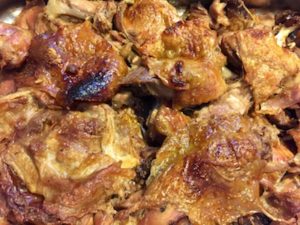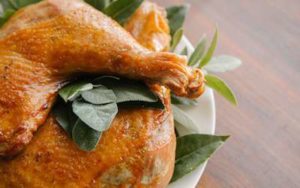
The new tales of turkey “pope’s noses,” Salt Restaurant French turkey confit and East Indian Chai Turmeric brined turkey all have a substantial, if novel, global twist.
Let’s start with the tale of the tailor “pope’s nose”, actually a gland that attaches the turkey’s feathers to its body. It is filled with oil that the bird uses to preen itself, so about 75 percent of its nutritious calories come from fat. It’s that same “pope’s nose” that everyone in our family used to try to sneak away before the chicken came to table.
However, whole turkeys gracing just about 90 percent of the holiday tables in the US are missing their “tail” although I’ve found one in the giblet bag about twice in my 22 years of cooking the bird for TV.
 But the poultry industry took care of that. And this tale of the tail shows how this industry influenced one nation’s less favored food to become popular in another nation through clever marketing.
But the poultry industry took care of that. And this tale of the tail shows how this industry influenced one nation’s less favored food to become popular in another nation through clever marketing.
The story goes like this. Industrial-scale livestock production evolved after World War II through scientific advances such as antibiotics, growth hormones and, in the case of the turkey, artificial insemination to make the white meat breasts the big standout; turkey tail went by the wayside. Nevertheless, when U.S. commercial turkey production increased from 16 million pounds in January 1960 to 500 million pounds (or about 250 million birds) in January 2017, it included a quarter-billion (extraneous) turkey tails.
By 2007, the tails had become such a popular social item, washed down by beer much like chicken wings in America, that the average Samoan was consuming more than 44 pounds of turkey tails yearly, almost triple the amount of turkey Americans consume annually!

The “pope’s noses” also drove up the American Samoan obesity rate to a whopping 75%. Samoan officials grew so concerned that they banned turkey tail imports in 2007 — a ban the Samoans had lifted in 2013 as a condition of joining the WTO. To read the full text, visit //col.st/4DGuM. Will turkey tails make a comeback in the US like short ribs, offals — and lobster in the past?
SALT Restaurant & Bar at The Marina Del Rey Hotel overlooking the water, open from 11:00 a.m. to midnight on Thanksgiving, offering guests a special holiday menu featuring a French-inspired confit of the thigh. Mary’s Organic Turkey is served with the confit, a butter poached breast, sweet potato and roasted Brussel sprouts. SALT also offers an extensively curated wine list. For details, please see //www.marinadelreyhotel.com/SALT-restaurant-and-bar
 Confit comes from the French term, configure, literally meaning “to preserve”. So a confit defines any type of food cooked slowly over a long period of time as a method of preservation. To prepare a turkey thigh confit at home, here is Guy Fieri’s recipe: //www.foodnetwork.com/recipes/guy-fieri/turkey-leg-confit-with-shallots-and-thyme-3162654
Confit comes from the French term, configure, literally meaning “to preserve”. So a confit defines any type of food cooked slowly over a long period of time as a method of preservation. To prepare a turkey thigh confit at home, here is Guy Fieri’s recipe: //www.foodnetwork.com/recipes/guy-fieri/turkey-leg-confit-with-shallots-and-thyme-3162654
East-Indian inspired Turmeric Chai Tea inspired “Dish It Girl”, Dina Deleasa, to brine turkey in it for a new ethnic spin. She enhances the tea’s organic blend of robust flavors like spicy ginger and pepper by adding fresh fennel, sage, thyme, and rosemary. Watch Dina prepare Turmeric Chai Tea turkey. “Bringing the turkey may take a little extra time and effort but it makes for one juicy bird. Using tea instead of water, helps it become saturated in flavor,” says Chef Dina. I also used some in the bottom of the roasting pan for gravy purposes.”






 Gerry Furth-Sides
Gerry Furth-Sides  Barbara Hansen
Barbara Hansen  Chef-owner Alain Cohen
Chef-owner Alain Cohen  Roberta Deen
Roberta Deen  Jose Martinez
Jose Martinez  Nivedita Basu
Nivedita Basu